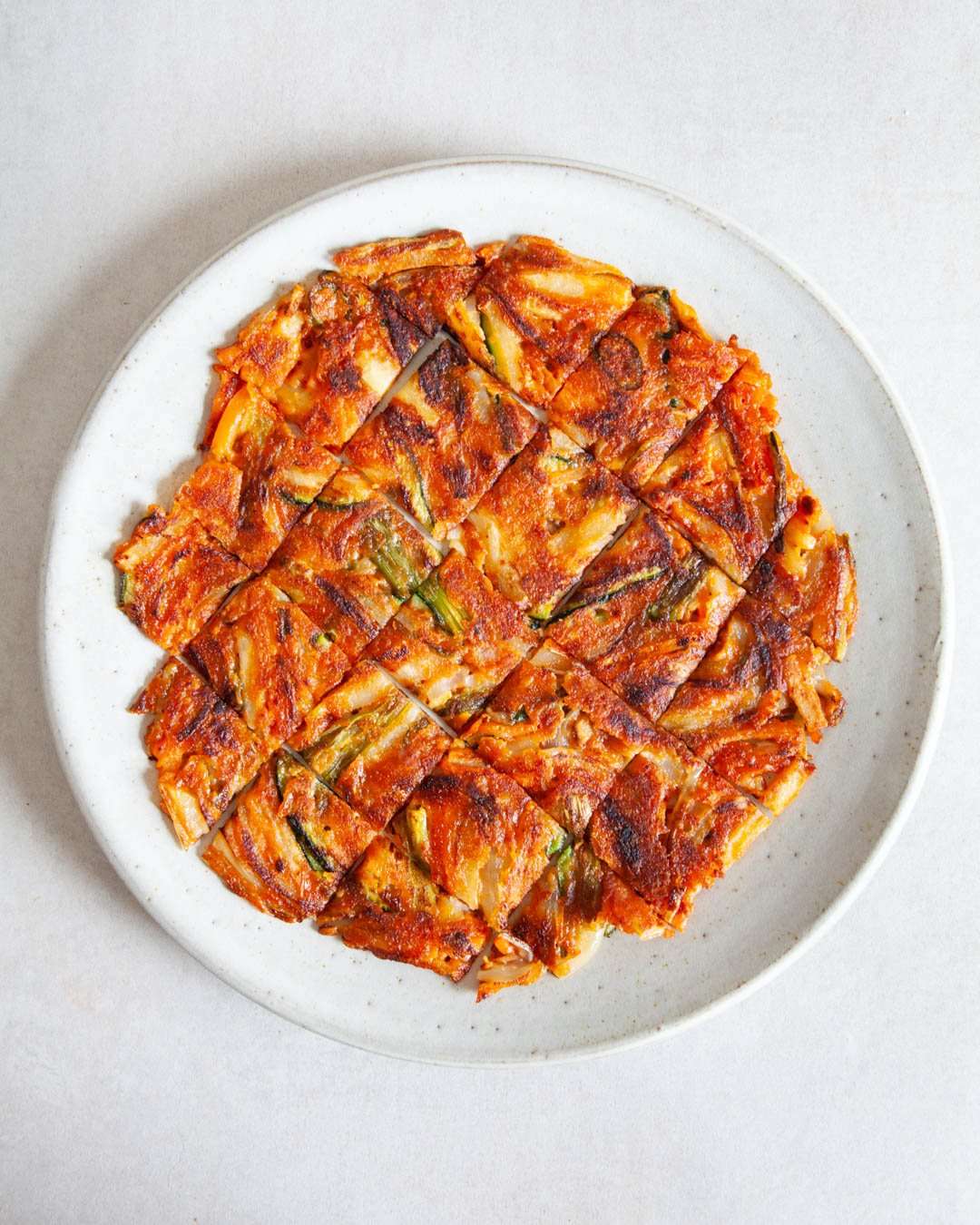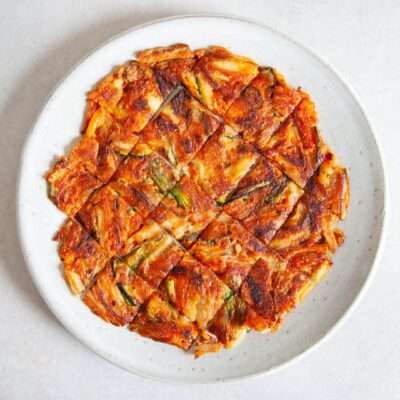Gochujang Yachaejeon (Gochujang-Flavored Vegetable Pancakes)

If you’ve wondered what to do with the leftover veg that’s been accumulating in your fridge, I’d like to introduce you to Yachaejeon. In Korean, “yachae” means vegetable and “jeon” means pancake and it’s exactly that, a thin savoury vegetable pancake that is served with a lip-smacking dipping sauce.
Although not traditional, I love adding gochujang to the simple flour and water-based batter. It adds a layer of spicy umami as well as a satisfying red colour to the pancakes. I used Sempio’s Gochujang for this recipe.
What is Gochujang?
Gochujang is a Korean fermented chilli paste that is widely used in Korean cuisine as a seasoning and condiment. It has a complex, savoury, and slightly sweet flavour with a distinct spiciness.
Traditionally, gochujang is made from red chilli powder, glutinous rice, fermented soybeans, salt and water. Other common ingredients include malt barley powder or syrup, sugar and sometimes other aromatics like garlic.
To make gochujang, the ingredients are mixed together and then fermented for several months to a year. During the fermentation process, beneficial bacteria and yeasts break down the starches in the rice and soybeans, producing lactic acid, which gives the paste its characteristic tanginess and umami flavour. The fermentation also helps to deepen the colour and flavour of the chilli paste.
What are Yachaejeon
Yachaejeon is a type of Korean pancake that is made with various vegetables. “Yachae” means vegetables in Korean, and “jeon” refers to a type of savory pancake that is commonly eaten in Korea as a snack or appetiser.
The vegetables used in yachaejeon can vary but commonly include spring onions, courgette, carrots, potatoes, chilli and onion. The vegetables are typically thinly sliced or julienned and mixed together with a batter made from flour and water.
To cook Yachaejeon, the batter and vegetables are spooned onto a hot, oiled pan and cooked until crispy and golden brown on both sides. It is usually served with a dipping sauce made from soy sauce, vinegar, gochugaru and sesame seeds.
Yachaejeon is a popular dish in Korea, particularly during the spring when many of the vegetables used in the dish are in season. It is often served as a side dish or appetiser in Korean restaurants, but can also be found at street food stalls and markets.
serves 2
Ingredients
Dipping Sauce
-
2 tbsp soy sauce
-
2 tbsp rice vinegar
-
1 tsp gochugaru (Korean pepper powder)
-
1 tsp sesame seeds
Veg
-
1/2 courgette
-
1/2 large carrot
-
1/2 large potato
-
1/2 onion
-
1 mushroom
-
1 green chilli
-
5 spring onions
Pancakes
-
130g bread flour
-
180 ml water
-
1 tbsp gochujang (I used Sempio’s Gochujang)
-
oil for frying
Method
Start with the dipping sauce. Just combine the soy sauce, rice vinegar and chilli flakes. Toast the sesame seeds until golden and add to the sauce.
Julienne the courgette, carrot and potato. Peel and finely slice the onion, thinly slice the mushroom and chilli and cut the spring onions into large 3-5 cm pieces. Then transfer the veg to a bowl and toss to mix.
Combine the bread flour, water and gochujang along with 1/2 tsp salt and whisk well. Then mix the veg through the batter until everything is evenly coated.
Heat some oil in a large non-stick frying pan and add half of the mixture. Add this point, the batter might only fill half of the pan, but use a spatula to flatten the veg until you have formed a thin even pancake. This is key, as a thick pancake will steam rather than fry and might not cook through in the centre. As the veg cooks and softens, it’ll be easier to spread out, so keep going. Fry the pancake for 4-5 minutes or until golden (gently lift one side with a spatula to peek underneath), then shake the pan to loosen it. Now confidently flip the pancake in one smooth motion. Drizzle some more oil around the sides, flatten the pancake even further with the spatula and fry for another 4-5 min until golden on the other side. Then transfer it to a board, cut it into squares and serve with the dipping sauce.
**I receive a small commission from affiliate links on this page**

Gochujang Pancakes
Ingredients
Dipping Sauce
- 2 tbsp soy sauce
- 2 tbsp rice vinegar
- 1 tsp gochugaru (Korean pepper powder)
- 1 tsp sesame seeds
Veg
- 1/2 courgette
- 1/2 large carrot
- 1/2 large potato
- 1/2 onion
- 1 mushroom
- 1 green chilli
- 5 spring onions
Pancakes
- 130 g bread flour
- 180 ml water
- 1 tbsp gochujang (I used Sempio’s Gochujang)
- Oil for frying
Instructions
- Start with the dipping sauce. Just combine the soy sauce, rice vinegar and chilli flakes. Toast the sesame seeds until golden and add to the sauce.
- Julienne the courgette, carrot and potato. Peel and finely slice the onion, thinly slice the mushroom and chilli and cut the spring onions into large 3-5 cm pieces. Then transfer the veg to a bowl and toss to mix.
- Combine the bread flour, water and gochujang along with 1/2 tsp salt and whisk well. Then mix the veg through the batter until everything is evenly coated.
- Heat some oil in a large non-stick frying pan and add half of the mixture. Add this point, the batter might only fill half of the pan, but use a spatula to flatten the veg until you have formed a thin even pancake. This is key, as a thick pancake will steam rather than fry and might not cook through in the centre. As the veg cooks and softens, it’ll be easier to spread out, so keep going. Fry the pancake for 4-5 minutes or until golden (gently lift one side with a spatula to peek underneath), then shake the pan to loosen it. Now confidently flip the pancake in one smooth motion. Drizzle some more oil around the sides, flatten the pancake even further with the spatula and fry for another 4-5 min until golden on the other side. Then transfer to a board, cut it into squares and serve with the dipping sauce.

Hi! What is bread flour? I suppose that ordinary multipurpose wheat flour can be used. I just found your blog. Interesting info and recipes.
Bread flour is usually a little higher in gluten than all-purpose/plain flour. It also absorbs a little more water than plain flour, but you can definitely substitute it for this recipe.
theres definitely a learning curve to keeping it together as a piece in the pan, but I love the flavor and it still hits as little crispy pieces lol. also love that i can basically just throw in whatever i have in the fridge and the gochujang is gonna make it work anyway